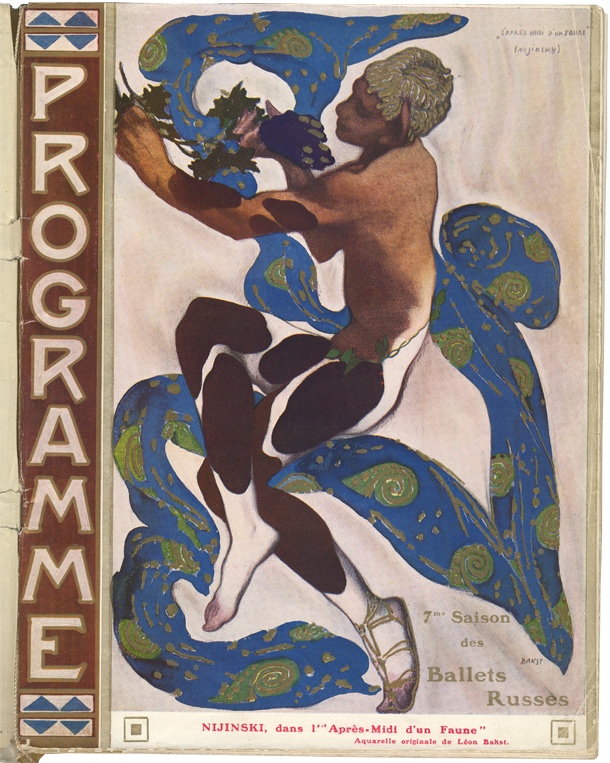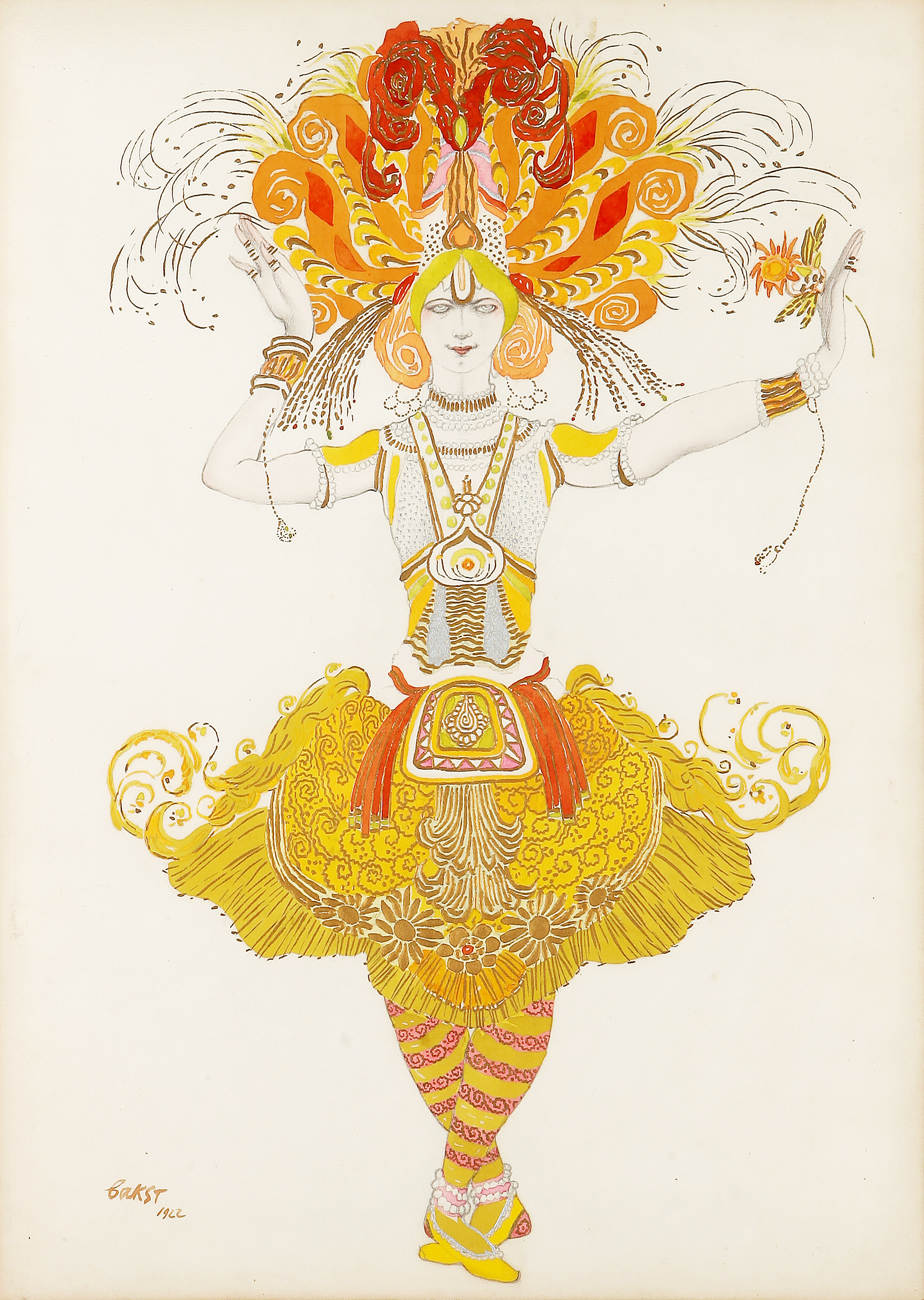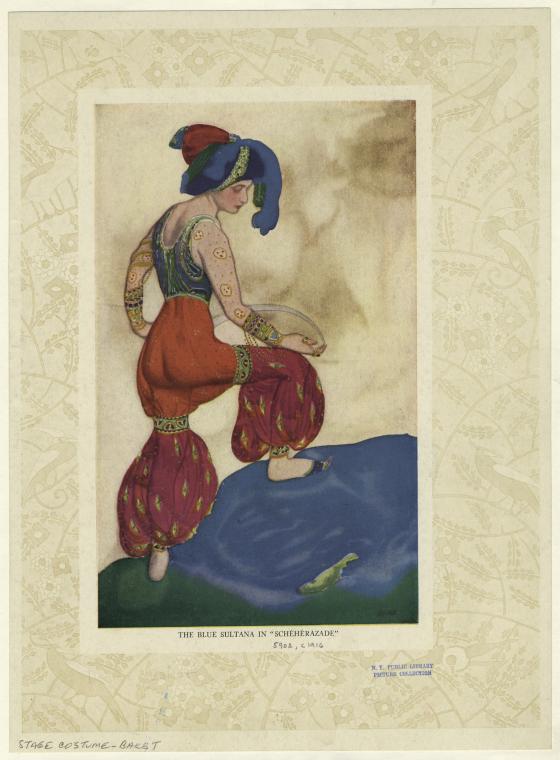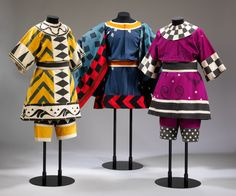1. Having dealt with and admired the sophisticated figurines by Paul Philippe, and the
elegant architecture by Pablo Monguió i Segura, we are ready to meet the genius of
Léon BAKST, originally Lev
Samoylovich Rosenberg,(Leib-Haim Izrailevich) born in 1866 (died 27th
December 1924, Paris, France).
Jewish Russian artist who revolutionized theatrical design. Painter, graphic
artist, scene-designer, master of decorative and applied arts, and art
theoretician.
They rebelled against 19th
century stage realism, which had turned pretentious and unimaginative lacking theatricality.
Bakst’s designs for the Ballets Russes were opulent and
innovative, and his influence on fashion and interior design was widespread.

2. Overnight European ideas about
ballet were overturned and ballet became an
important art form. The success of Vaslav
Nijinsky
and Adolph Bolm restored the male dancer
to popularity, the dancers became household names, and the designers the
rage of Paris.
Schéhérazade, with music by Nikolai Rimsky-Korsakov, libretto by Léon Bakst,
Alexandre Benois and Michel Fokine, and sets and
costumes designed by Leon Bakst, was premiered
4th June in 1910 at the Theatre National de l’Opéra de
Paris with Ida Rubinstein and Vaslav Nijinsky. The influence it cast on the
world of art, music, culture, fashion (it inspired a fashion for harem pants, turbans
and floor cushions), and literature was unprecedented, and is
still a source of fascination to this day. It was performed over five
hundred times between 1910 and 1929.

This dance drama was the first production completely devised by Diaghilev and his collaborators, bringing together vivid visual spectacle, powerful choreography and a re-orchestrated version of the 1888 symphonic suite that Rimsky-Korsakov had based on tales from The Arabian nights. Bakst’s costumes are an imagined orientalist amalgam of Ottoman and Persian styles, pale and diaphanous silk harem pants for the almées contrasting with strongly coloured, embroidered and intricately structured silk and velvet costumes for the lead male characters. Bakst’s drawing for Shah Zeman is an earlier, more ornate, version of the Shah’s actual costume, accentuating the strong rhythms of the dancer’s body by depicting the fabrics and the skirt ornaments as moving and floating. With gold body paint and bejewelled outfit, Nijinsky commanded the stage with his voluptuous and feline performance as Zoebéide’s favourite slave. Against the set’s emerald green walls and red carpets, the massed costumes of dancers in frenzied motion created a moving spectacle of colour intensifying towards the ballet’s orgiastic and violent climax.

 3. However, I would like to remark another ballet
3. However, I would like to remark another ballet
The Firebird (ballet in one act and one tableux).
As a reaction from Paris
criticism demanding an innovative musical composition
according to the new ballet design, Diaghilev turned to the young composer Igor STRAVINSKY. The Firebird represented
Stravinsky’s first commission from the Ballets Russes and proved to be the
catalyst that began his ascent to international acclaim.
The premiere was on 25
June 1910, Théâtre National de l’Opéra, Paris.
It
is considered one of Michel Fokine’s best choreographies and one of Diaghilev’s
most successful collaborative efforts [The work was restaged in 1926 with sets
and costumes by Natalia
Goncharova.]


 http://www.harteconhache.com/2011/10/la-pajara-de-tamara-karsavina.html
http://www.harteconhache.com/2011/10/la-pajara-de-tamara-karsavina.htmlThis is the work of art which I have chosen to analyse. The astonishing apparel of the Firebird builds movement and dynamism all around the design. The surreal nature of the character is reflected in the body features, its limbs, and basically its face.
Her
long golden plaits frame the character in bending position. The striking yellow,
orange and red predominant colours highlight the impossible balance of a static
picture.
A
triangle shape set at the centre of the drawing becomes the focus of attention.
It displays a pattern of flying birds and flowers. Then, the sight seems to
raise and fall clockwise following the feathers skirt at the back.
Bakst’s
goal was to design the protagonist in the ballet, the fabulous creature, the
Firebird.
The
whole array conveys the character’s nature and story. It is a vehicle to drive
the spectator into the realms of fantasy, far away from conventions and
restrictions.
Symbolism
is a relevant aspect too. None of the elements chosen is optional. They are
meaningful and explicit instances of the character. Consequently, the profusion
of warm bright colours dazzles the observer. It might suggest confusion and
excitement.
The
silk thread lightness and transparency reveals with vivid realism the dancer’s
legs, muscles and flesh. The
exoticism of the richly embroidered pants and shoes lead our eyes to the left
to meet in a symmetrical fashion the
overskirt of feathers flowing around the energetic drawing, and pointing
towards an overellaborate headdress.
There
is a sharp contrast between the lower and upper part of the design. Her ample
bosom, her long arms which escape human shape to end up in claws...
Abstract lines define her neck and realistic proportion is deliberatedly abandoned.
Abstract lines define her neck and realistic proportion is deliberatedly abandoned.
Several
jewels complement the luxurious costume. A string of pearls holds her hair,
fine long earrings and a necklace which fastens her throat dangerously.
A
sophisticated blue and purple flowered belt in a heart-shape tightens her
waist.Traditionally, the turkey’s feathers on the skirt and on the headdress stand for abundance, pride and fertility. Once again, it seems to play with symbolism reminiscence and irreverence.
A bracelet combining the dress oriental pattern with a large red stone completes the glowing spinning vision.
Therefore,
the spectator is thrown in quest of further detail. This path, inevitably leads
us to her terrible face. A mask. Gorgon like. Her plaited hair miming the
snakes of the Greek mythical creature.
An
expert from the MOMA in New York considers this design as an artwork. However,
other people disagree. I would not dare argue scholars. All in all, Bakst was a
painter who developed and turned to different fields of art, photography,
settings and costume design included. Obviously,
he became an innovative and unprecedented artist.
This
particular sample of his art has made an impression on me. Not only the
drawing, but León Bakst as a total artist. As he, together with Diaghilev’s
company and others later on, came out with a brand new approach to art, music,
culture, and broadly speaking a new perspective on life.
Tamara Karsavina y Adolphe
Bolm The Firebird
For further information.
https://youtu.be/mUwdyN27TWI (Igor STRAVINSKY conducts The Firebird)
www.loc.gov/item/ihas.200185194/ (Library of Congress)









No hay comentarios :
Publicar un comentario